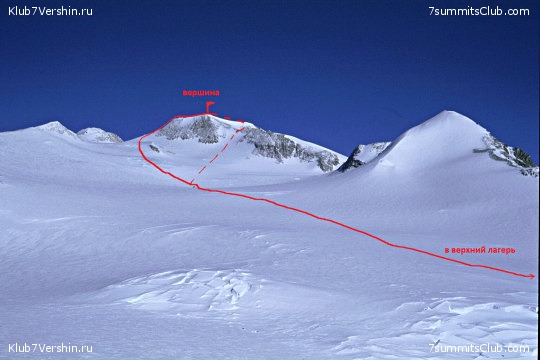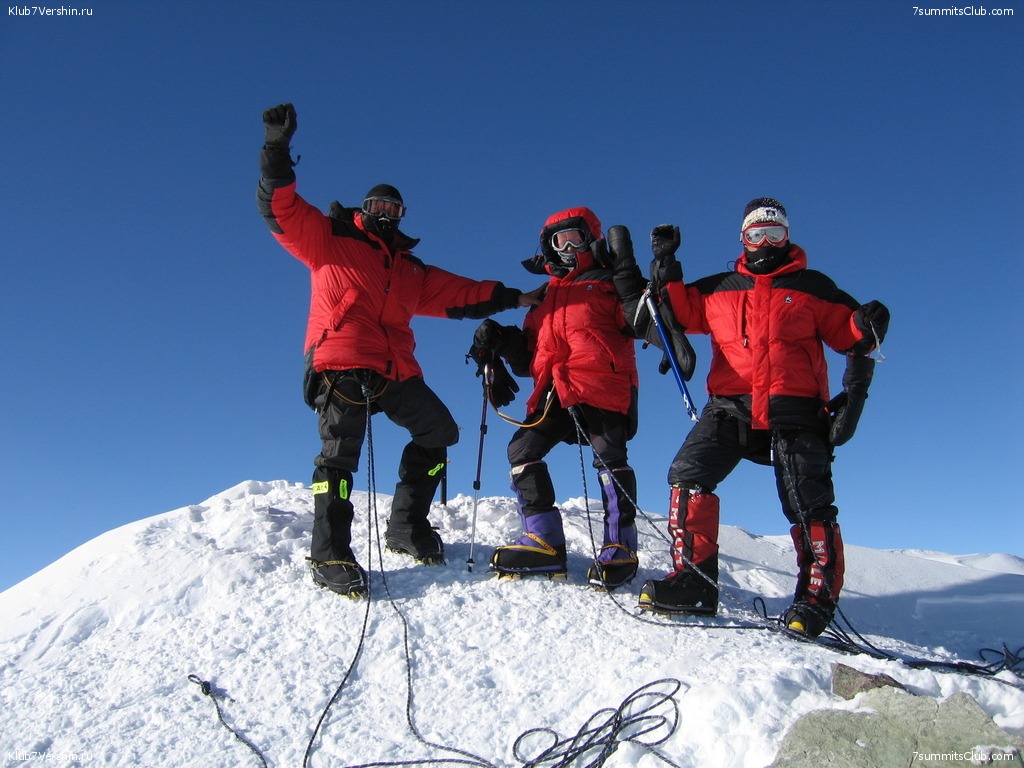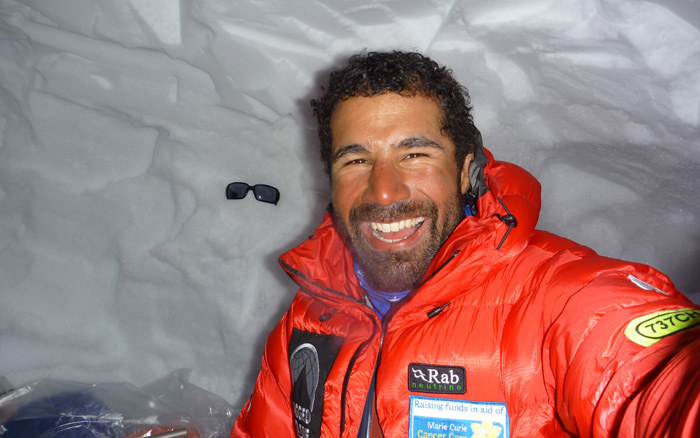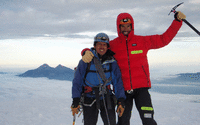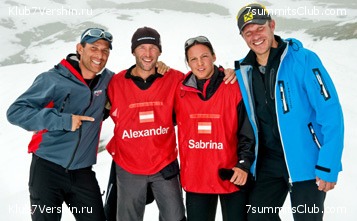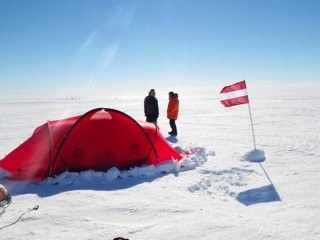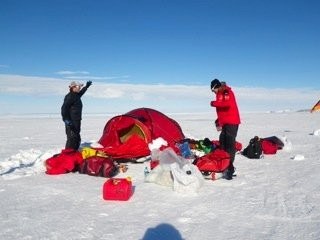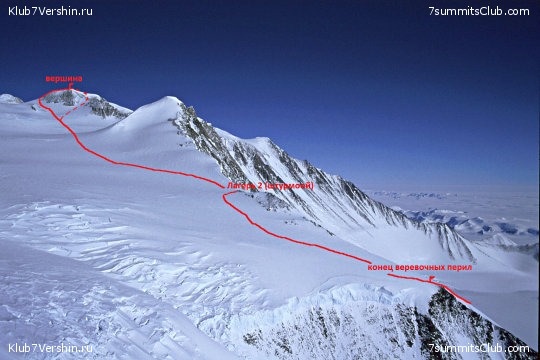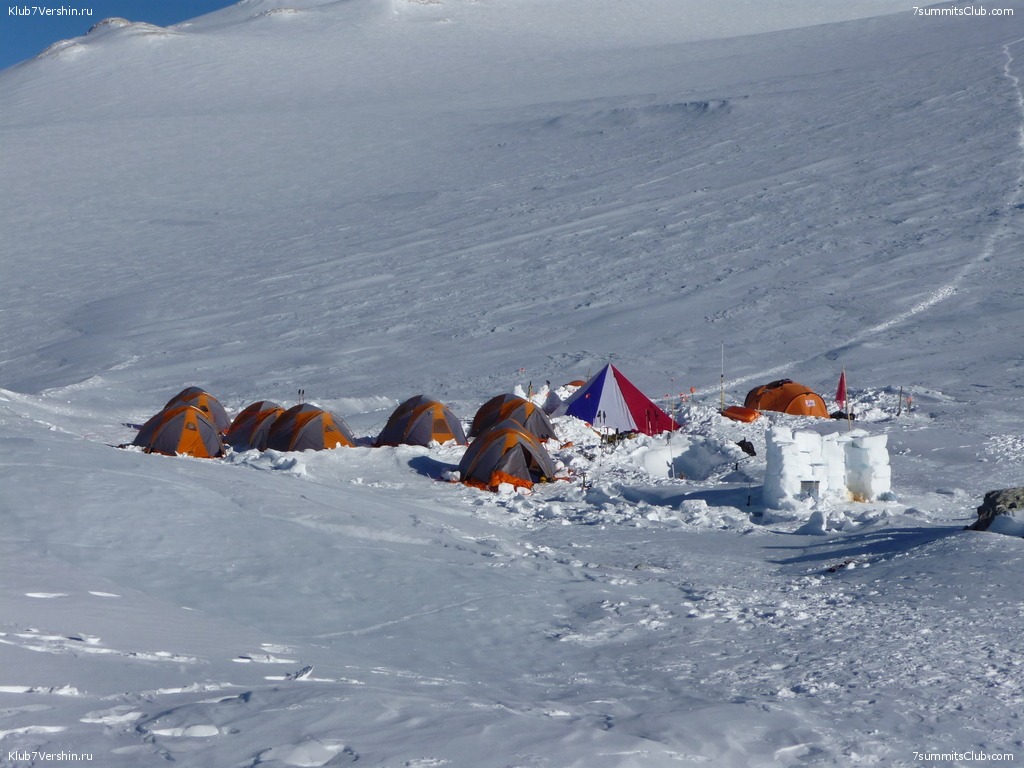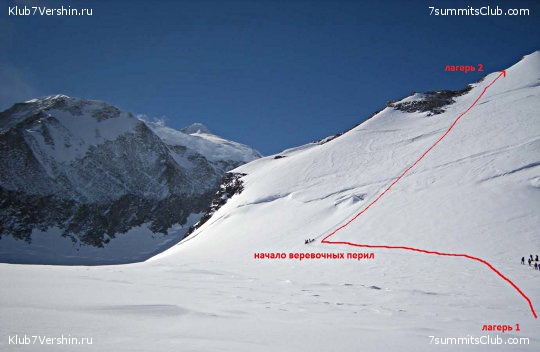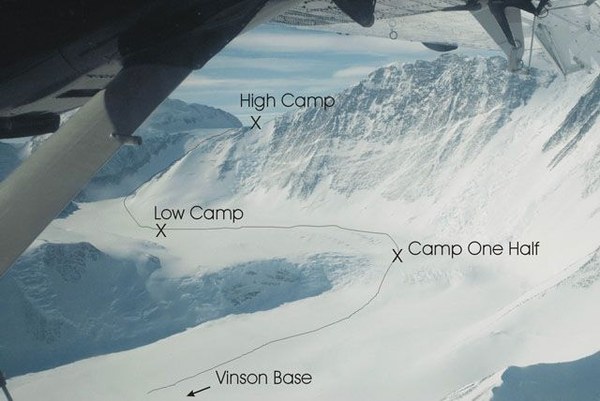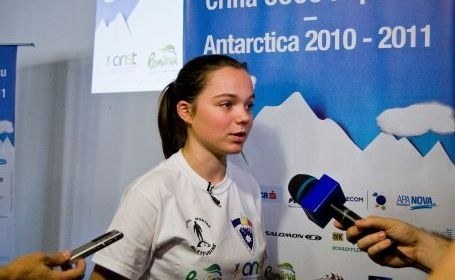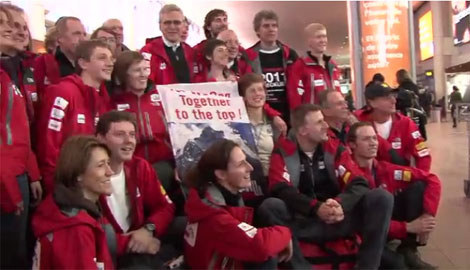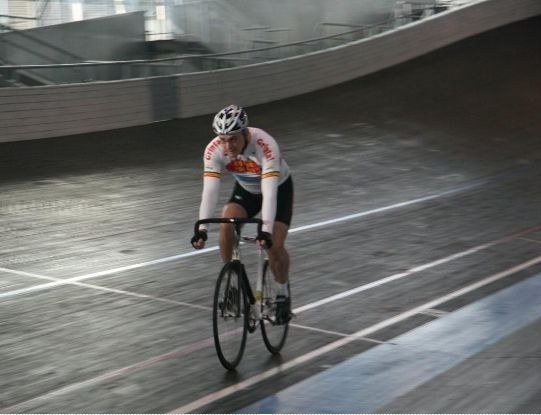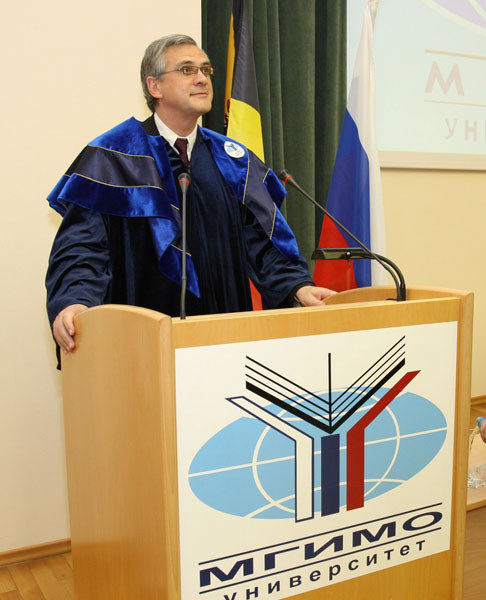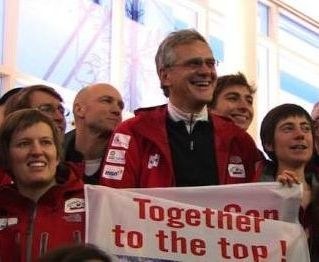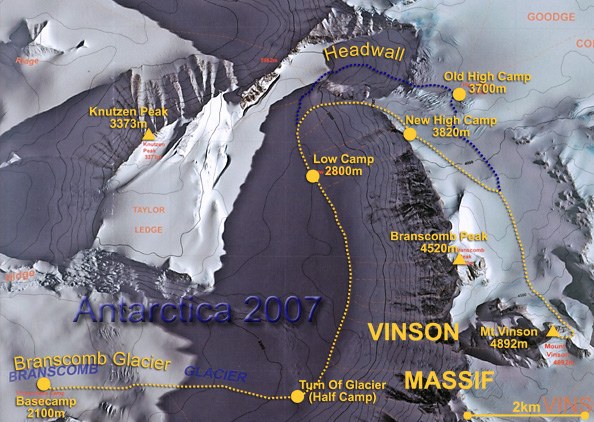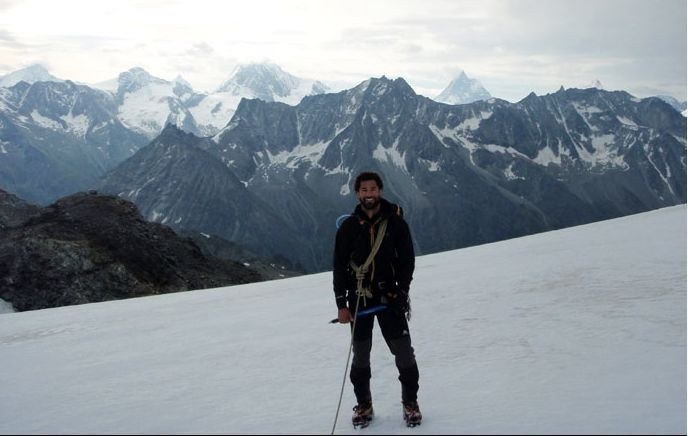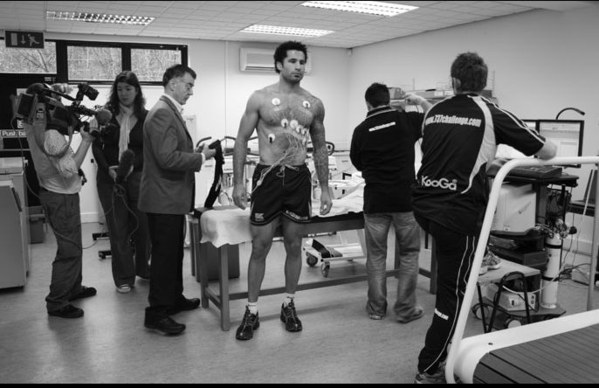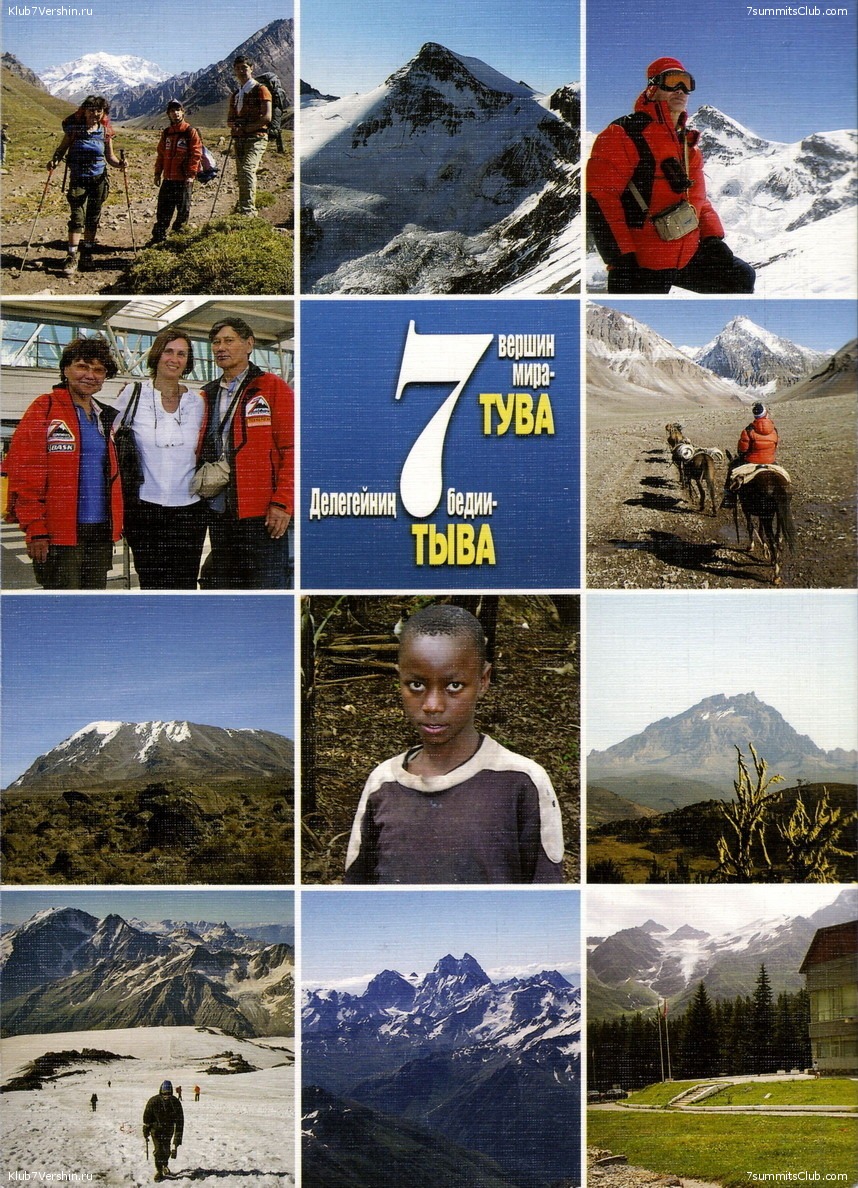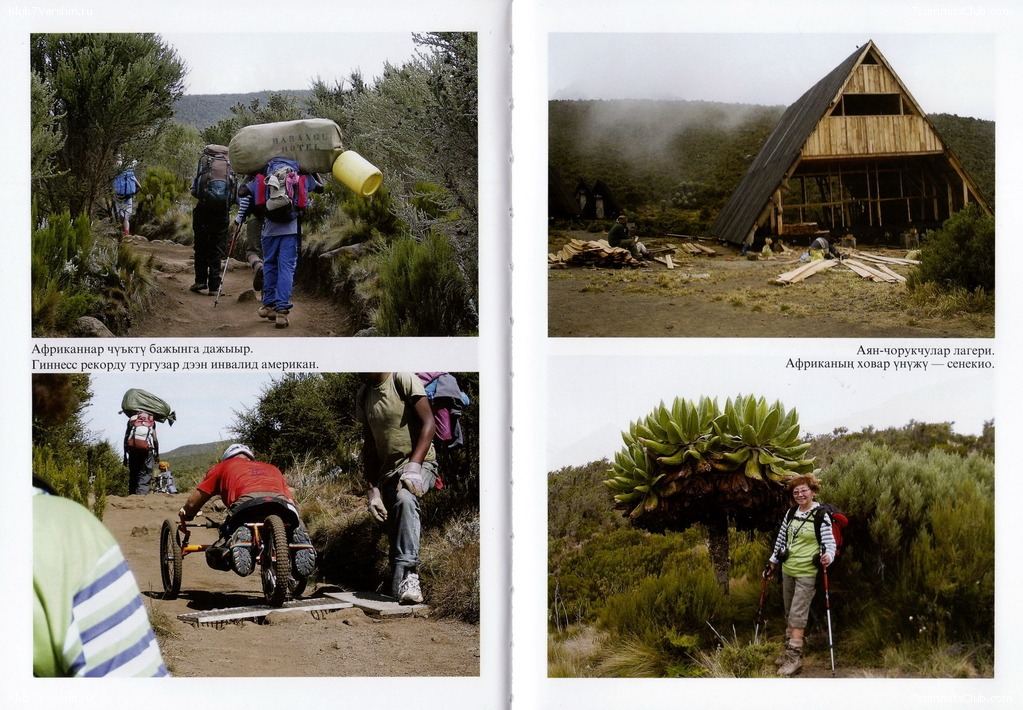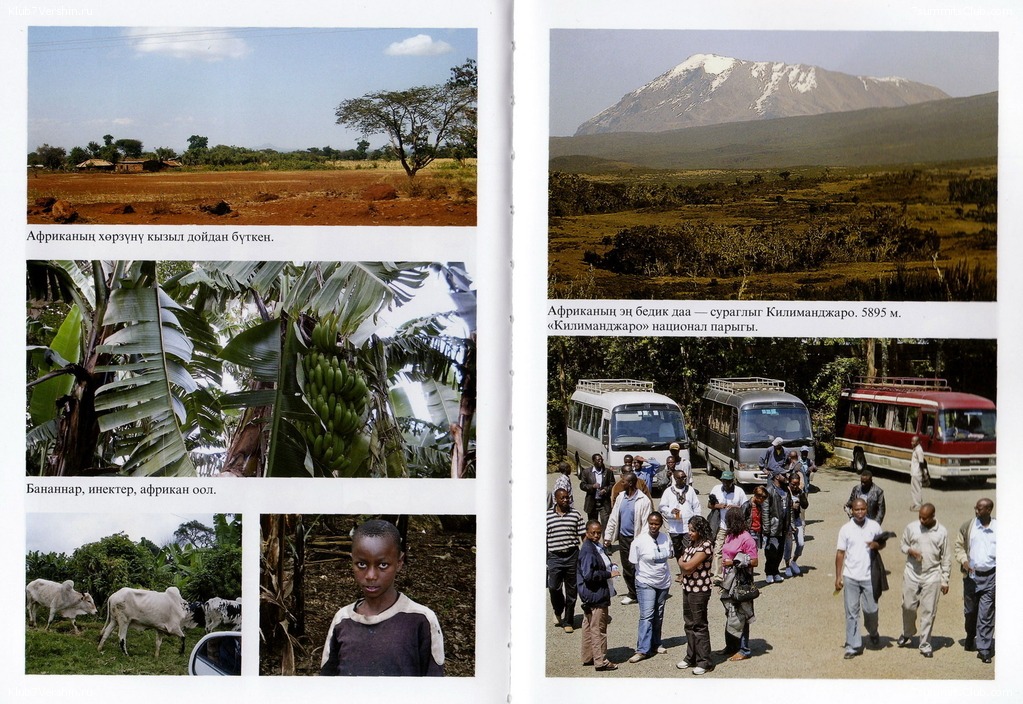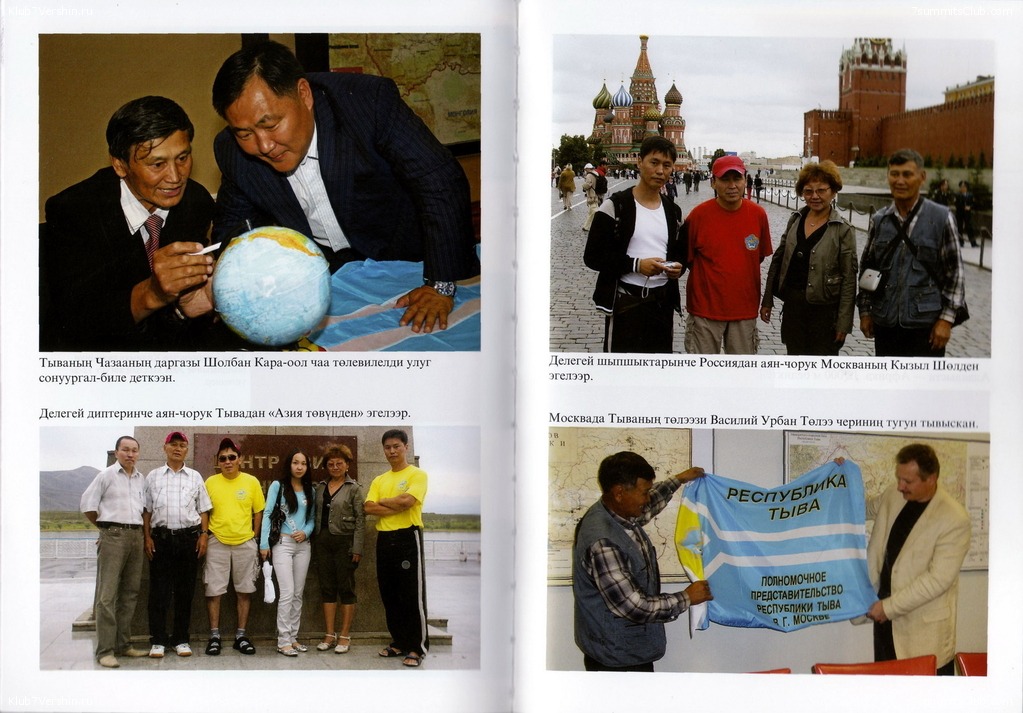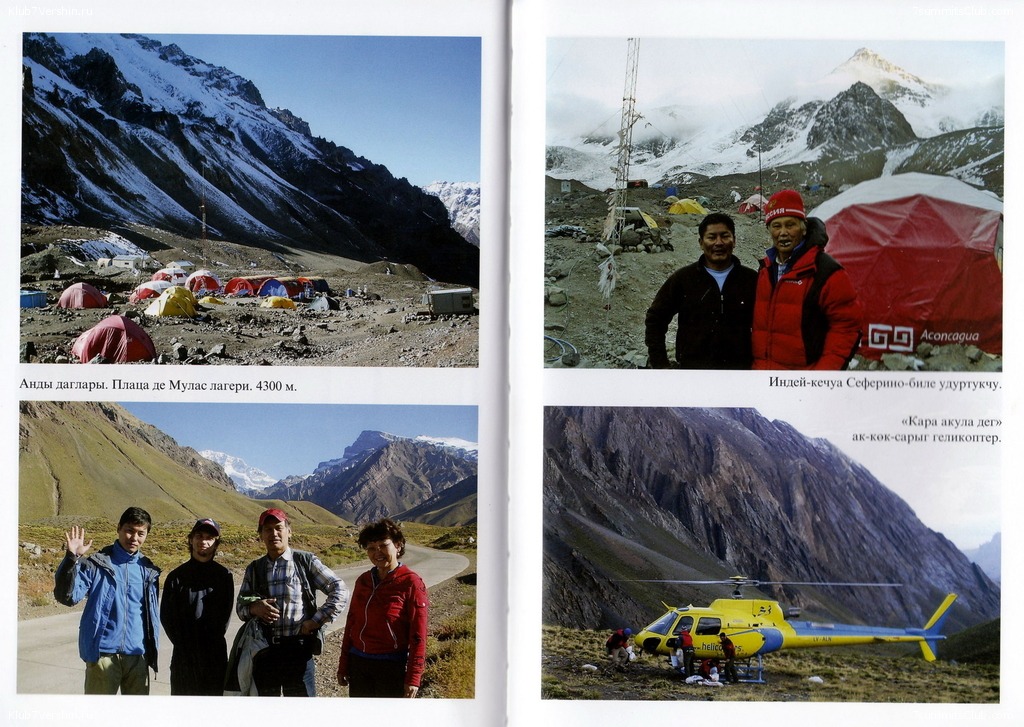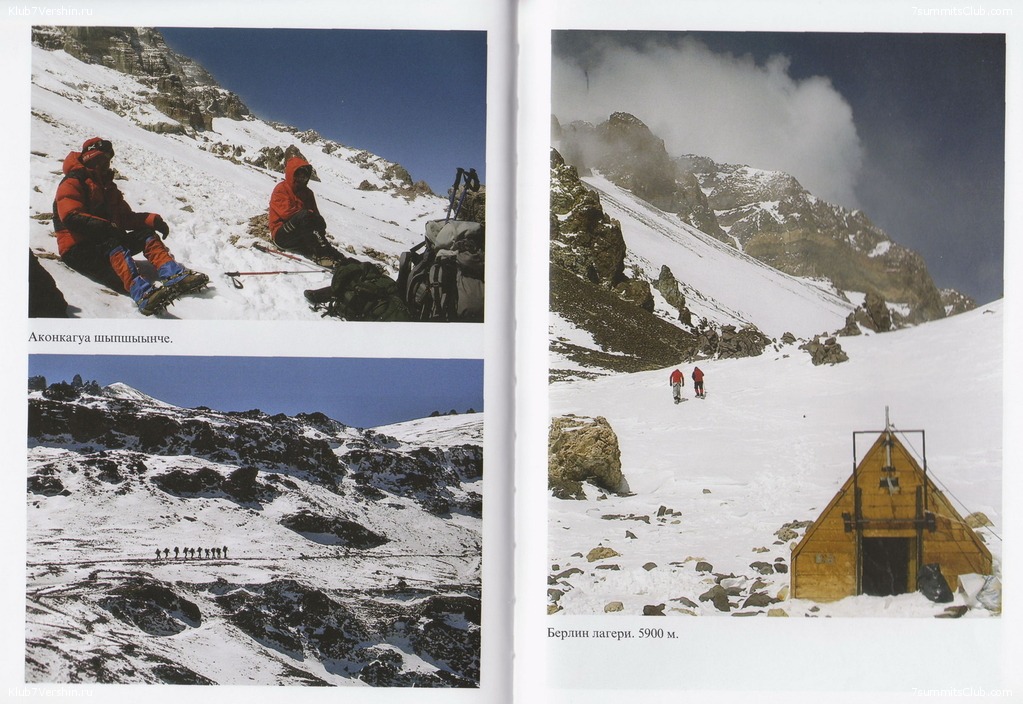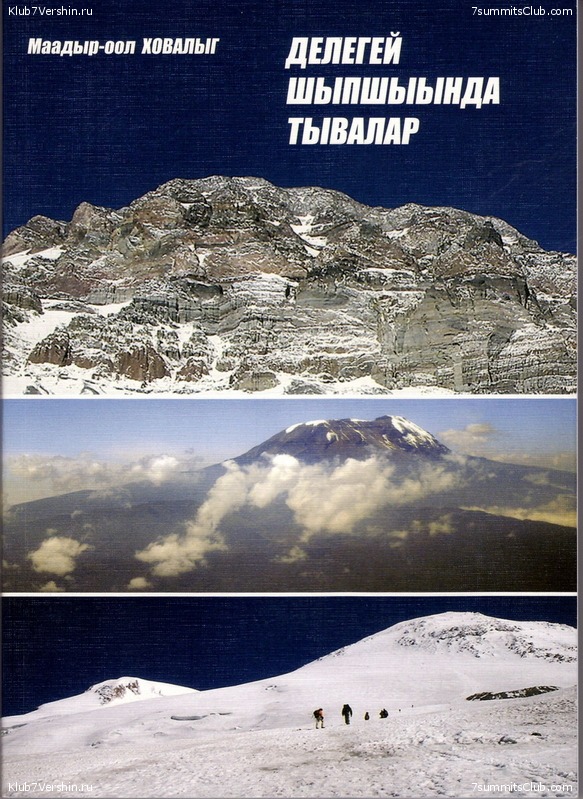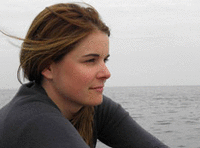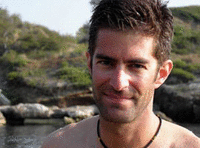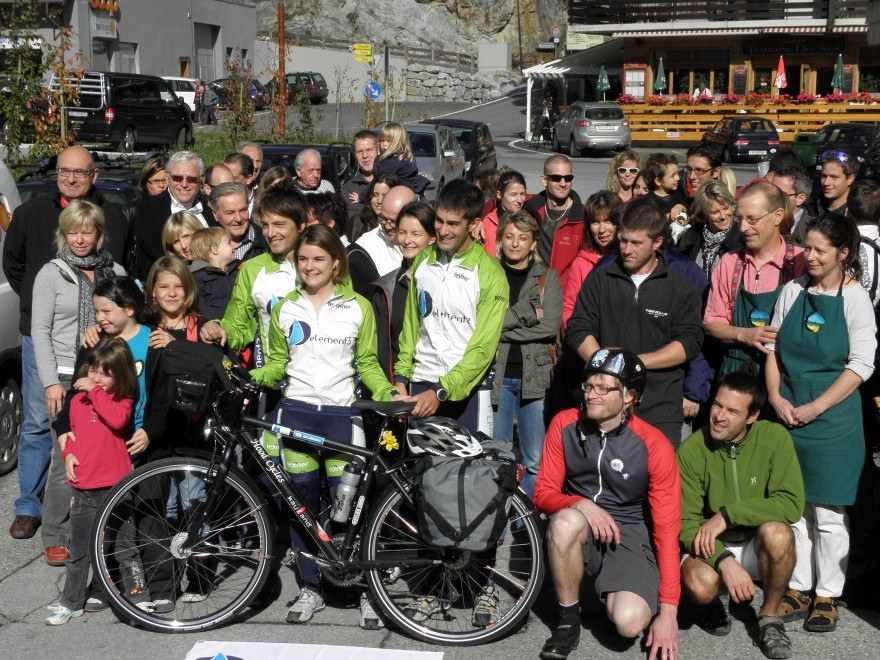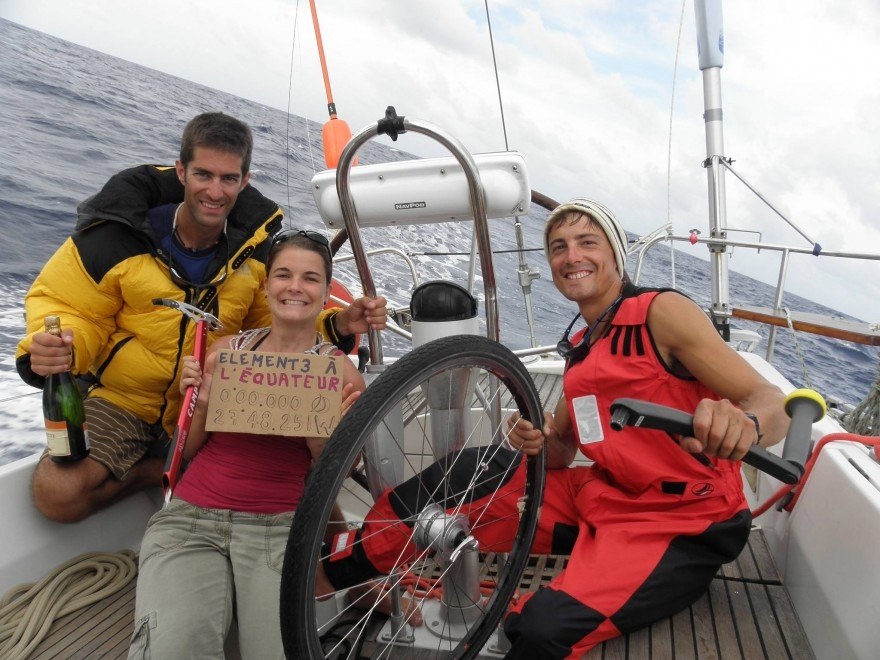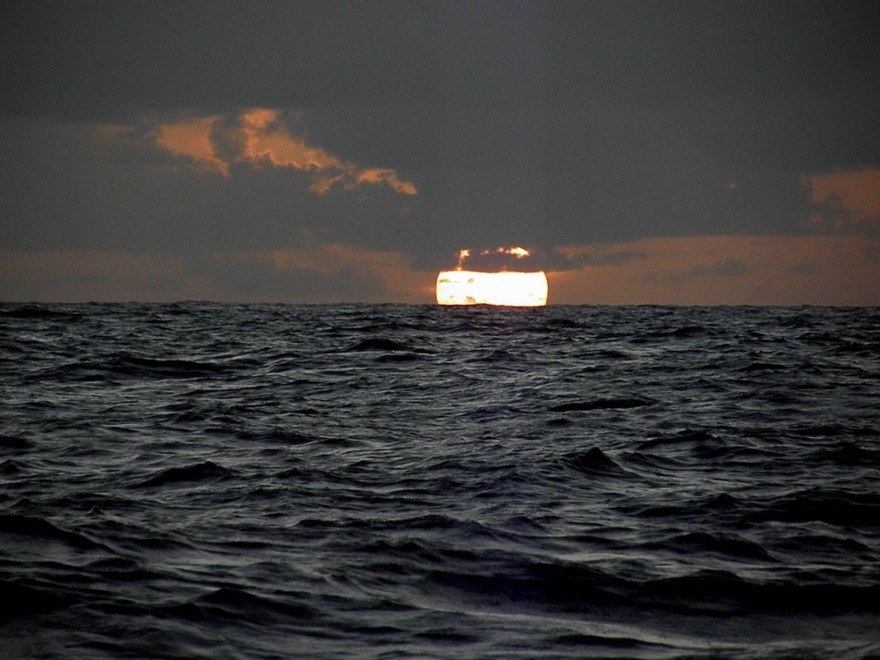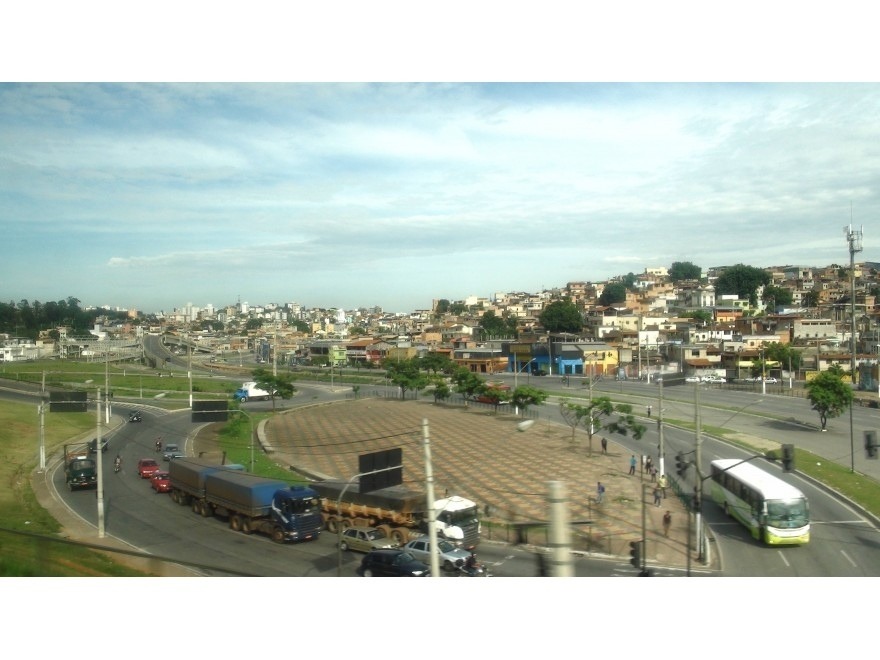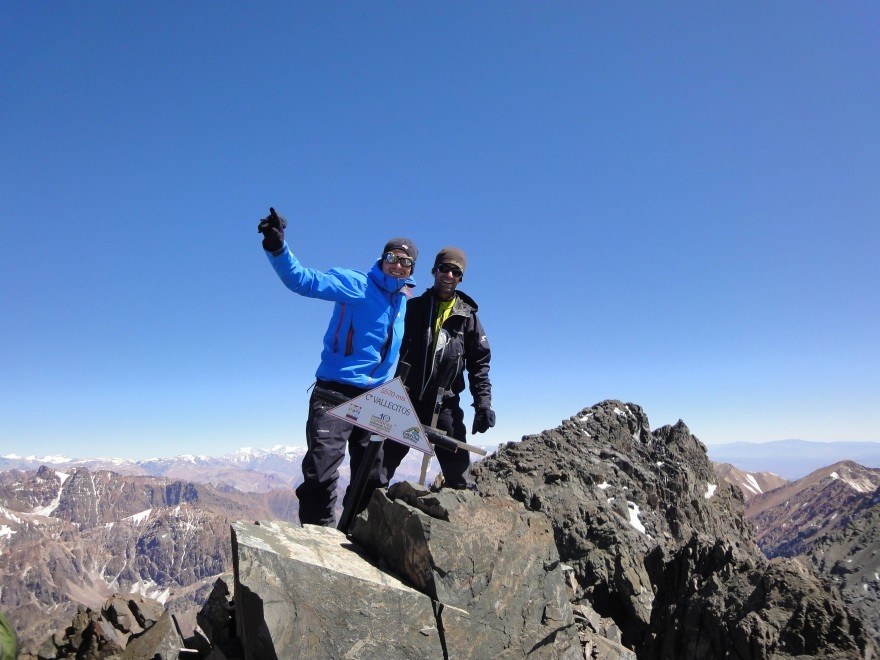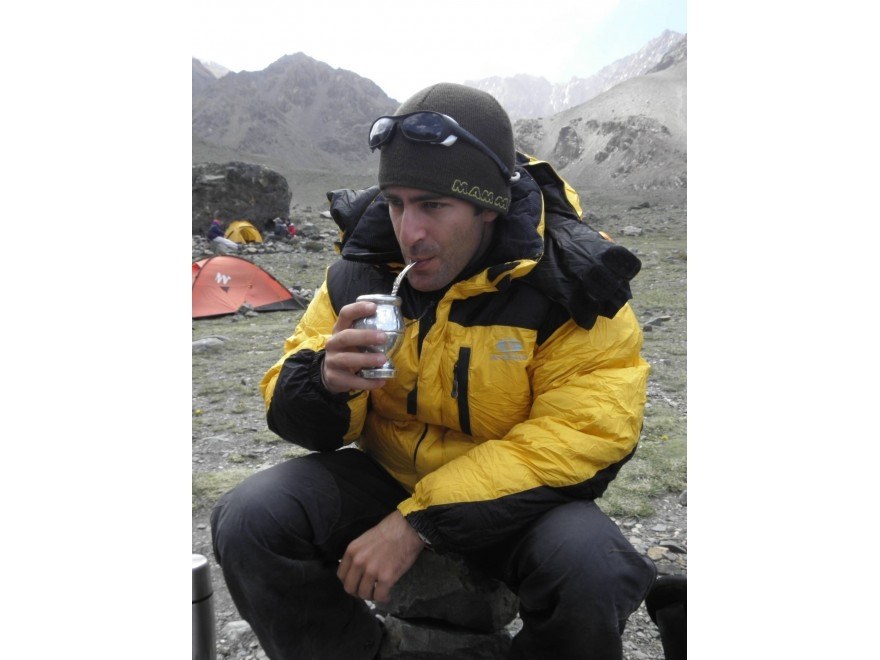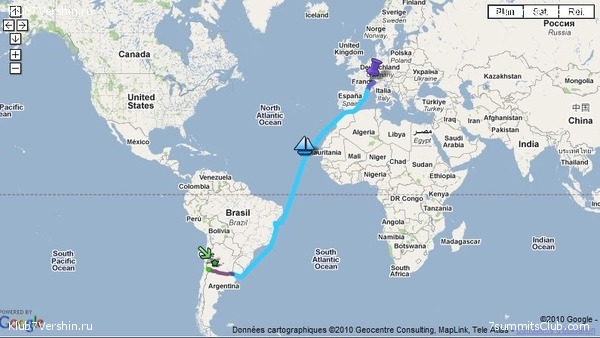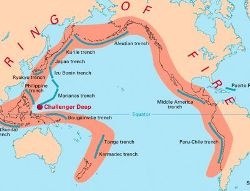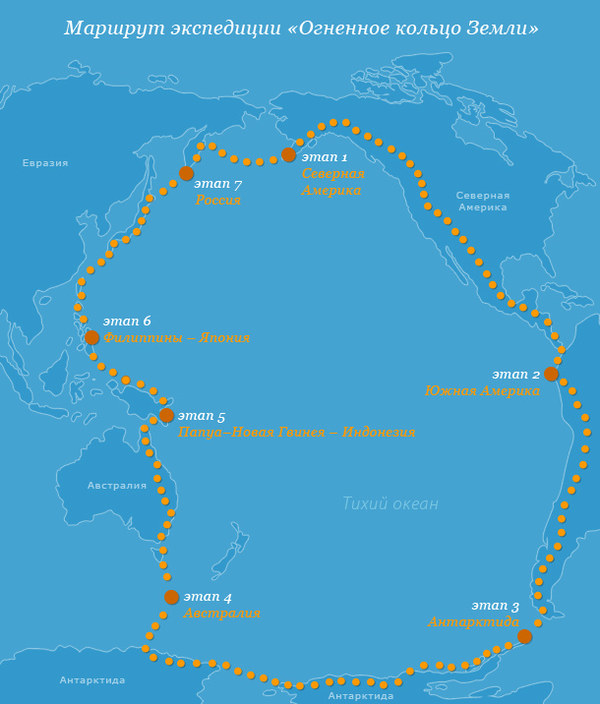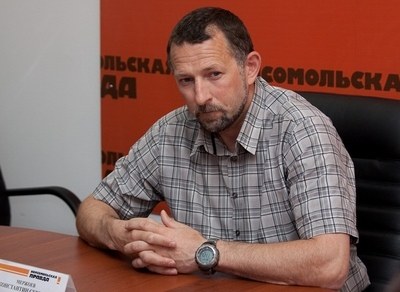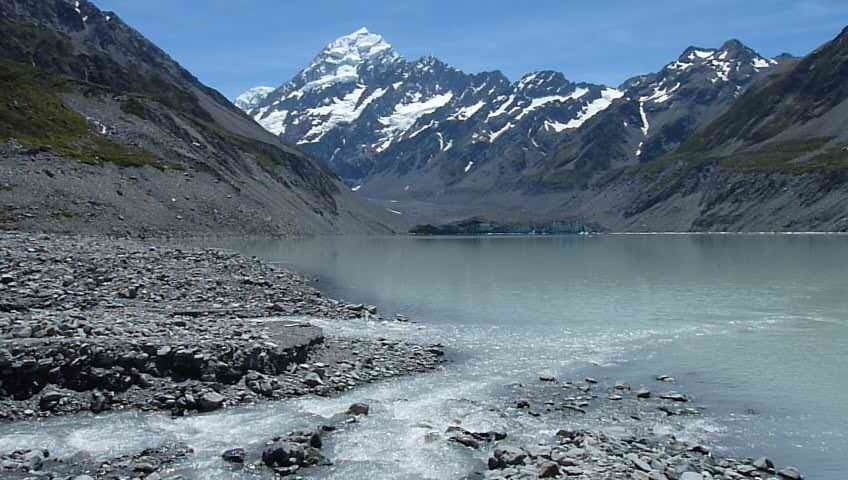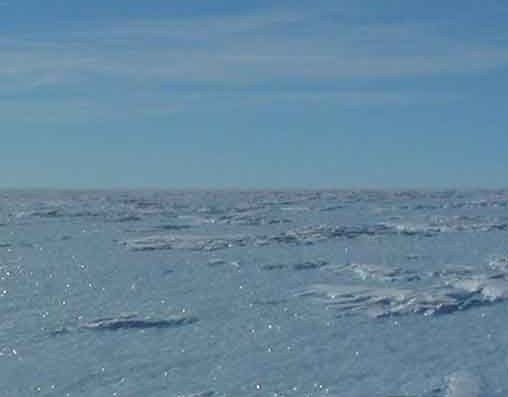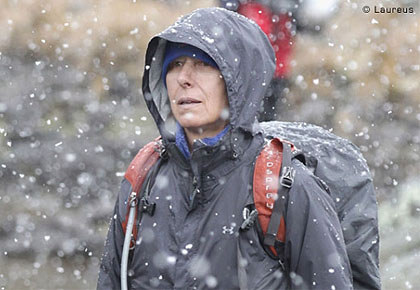All news
Alex Abramov: a call from the summit of Vinson
Vinson.
We stay on the highest peak in Antarctica: Alexander Abramov, Dmitry Kolotiy and Andrey Podolyan. We have a strong, powerful team, climbing was done very quickly. The weather is perfect, I never have seen such weather on the Vinson. Now ...
We stay on the highest peak in Antarctica: Alexander Abramov, Dmitry Kolotiy and Andrey Podolyan. We have a strong, powerful team, climbing was done very quickly. The weather is perfect, I never have seen such weather on the Vinson. Now we're going to undress from the waist up for making pictures. Undress completely is impossible because of the harness. Ten minutes later Donetsk team will begin to approach. For Sergei Kovalev it will be the completion of the program "Seven Summits". This evening and at night we hope to celebrate this event already in the base camp. We have there 4 bottles of vodka. On the way we collect intermediate camps, and leave all equipment at the base camp for the next our group. We want to fly the 28 th to the Union Glacier and we have a chance ...
Best regards !
Thank you for your support!
Photos from the expeditions of previous years
South Pole: Richard Parks reaches the Pole, a loss in the Austrian ORF team
South Pole.
www.737challenge.com. 27th December 2010. Richard Parks completed the first leg of his world first 737 Challenge this morning, arriving at the South Pole and completing the first of 3 poles he will face during his 7-month race to ...
www.737challenge.com. 27th December 2010. Richard Parks completed the first leg of his world first 737 Challenge this morning, arriving at the South Pole and completing the first of 3 poles he will face during his 7-month race to climb the highest mountain on each of the world’s continents and venture to The South and Geographical North Poles.
Richard arrived at the pole at 6.10 am UK time, 3.10am Chilean time and 7.10pm local time.
Richard will now stay on the South Pole, the southernmost point on the surface of the Earth until January 1st to ensure he reaches all poles within the same calendar year, ensuring his world record is complete at the end of the challenge.
The world's 3 Poles are The South Pole, The Geographic North Pole and the summit of Everest. The top, bottom and roof of the world. Today marked a historical day for Richard and his incredible world first expedition.
Richard Parks
BORN IN PONTYPRIDD, WALES, 14TH AUGUST 1977.
Richard Parks is a former Welsh international rugby player, earning caps against South Africa, Fiji, Scotland and Ireland. He also represented the Barbarians and Wales Sevens on the IRB world circuit and in the World Cup.
--------------------------------------------------------------------------------------------------------------------------
December 26 Two teams of Austrian and German television (ORF and ZDF) have passed the midpoint of their media race "Wettlauf zum Südpol". The full length of the route - 400 km. In accordance with the plan at half-way a stop has been made. Primarily for medical purposes. Doctors banned from further participation Alex Serdyukov from the team of Austria due of frostbitten fingers. They are confident that everything will be without serious consequences. Last part or route, Sabrina Grillitsch, Tom Walek and Hermann Maier will go at three. This is a minimal quantity for allowed for finish.
Alex Abramov: Great mood and excellent weather in the High Camp…
Vinson.
Hello ! Today, 26th of December. The full team climbed to the High Camp and now ... the main thing is, that we all got it, and tomorrow in the morning, at 9 a.m., we start for climbing the summit. To raise flags sponsors on the ...
Hello !
Today, 26th of December. The full team climbed to the High Camp and now ... the main thing is, that we all got it, and tomorrow in the morning, at 9 a.m., we start for climbing the summit. To raise flags sponsors on the top, who has this flags. Well, in general, the weather is excellent, the mood is perfect, we ate, drank ... well, not without it…
Dima showed enthusiasm, broke a saw and two shovels, digging up our tents from ... from the snow ....
Well, in general, everything is OK, tomorrow at 9 a.m., we go. The mood is great. And 27 th of December we want immediately to get down to the base camp. We hope to fly next day to the Union Glacier.
Bye, everyone !
Good luck !
Meanwhile, a new Antarctic team came to Punta Arenas ...
Sidley.
A young Romanian climber Crina (Coco) Popescu and her father Ovidiu arrived December 26 in Punta Arenas, with a day late. The same day, the Polish part of our new team got (also adventure) to this Chilean town. This Zygmunt Wladyslaw ...
A young Romanian climber Crina (Coco) Popescu and her father Ovidiu arrived December 26 in Punta Arenas, with a day late. The same day, the Polish part of our new team got (also adventure) to this Chilean town. This Zygmunt Wladyslaw Berdychowski, Roman Ludwik Dzida, Daniel Mizera, Malgorzata Bozena Pierz-Pekala. Such is the international composition of our next team, that goes to the highest peak in Antarctica. A guide of 7 Summits Club Max Bogatyrev looked for all them in the local airport two days. In the sky of the planet happen terrible things, flights delayed and extended, this information does not manage to reach. So Max spent a lot of time at the airport before he could tell us "all fed, put to sleep. " Prior to departure of the ice continent, the group will be at least three days. To purchase products and take a course "antarkticologia" in the company of ALE...
Coco and Ovidiu Popescu
Alex Abramov: A quiet Christmas night ended with a crazy morning
South Pole.
When I woke up in the morning, it rattled in the tent. When I looked out, I saw as our kitchen tent was dropped. A morning in the Low Camp usually starts at 12 o'clock, when the sun comes out. At 12 a.m. we get a weather forecast for the ...
When I woke up in the morning, it rattled in the tent. When I looked out, I saw as our kitchen tent was dropped. A morning in the Low Camp usually starts at 12 o'clock, when the sun comes out. At 12 a.m. we get a weather forecast for the next day, usually for a couple of days. So, this morning started badly, it was a hurricane ...
I called all my boys and from 12 a.m. to 4 p.m., we built snow walls. The wind was blowing very strong, ripped shovels from our hands. By lunchtime, when we built all these walls of snow, the wind completely calmed down. We started to think about tomorrow, how we go to the High Camp, and the next day to climb to the top of Vinson. But now it is evening, and again the blizzard began. According to the forecast, tomorrow we expected a weakening of wind and the next day - perfect, perfect weather. It will be December 27.
We sit together in the kitchen tent, laughing. The wind howled outside the tent. We hope that tomorrow the weather will improve. And probably the day after tomorrow we will go to the top of the Mount Vinson.
So, wait for messages from Antarctica and not get bored.
Bye!
Alexander Abramov: On Christmas night, the weather miraculously established
Vinson.
27/12/2010 Hello! December 24 - the day before Christmas night. In the morning there was a terrible storm, a hurricane roared overhead, on the ridge. The wind reached a speed of 80-100 km per hour. Within days, there was no connection ...
27/12/2010 Hello! December 24 - the day before Christmas night. In the morning there was a terrible storm, a hurricane roared overhead, on the ridge. The wind reached a speed of 80-100 km per hour. Within days, there was no connection with the High Camp, where seven people left. We all worried, but today, at 12 a.m. they came to a connection. They said that there are a few broken tents, one tent flew away. But in general, everything is OK.
When we were in the High Camp and went down, I joked that at Christmas the weather must be good. And now, the Christmas night, at 2 a.m. the peace was established between heaven and earth. Deathly silence, the sun is shining. Here in Antarctica, the sun always shines. Just perfect weather, perfect visibility. Deathly silence. Probably tomorrow, seven climbers who spent several days in the High Camp, go on climb. We also have a plan. Tomorrow morning, we will hear the weather forecast, and if all goes well, tomorrow we leave for night in the High Camp. And the next day, probably December 26, we plan to climb Mount Vinson.
God help us !
Goodbye !
Coco Popescu leaves on Antarctica expedition
Vinson.
Tomorrow, 26th of December, we are waiting for her in Punta Arenas. Crina Coco Popescu will see her dream come true on Christmas Eve when she will leave for Punta Arenas to complete her most important expedition till now, „Antarctica ...
Tomorrow, 26th of December, we are waiting for her in Punta Arenas. Crina Coco Popescu will see her dream come true on Christmas Eve when she will leave for Punta Arenas to complete her most important expedition till now, „Antarctica 2010-2011”.
Crina will begin the new year by climbing the Mount Vinson (1-10 January 2011), then she’ll take the Romanian flag on the Sidley’s peak (14-23 January 2011). On 22nd of February she will return to Bucharest as „the youngest woman to complete the Volcano Seven Summits”. We are crossing our fingers for her and we’ll wait for her to come back home.
You will be keep you updated with news from the expedition on the Journal section. But, just so you know how will the Coco’s life adventure will look, here’s the schedule of the „Antarctica 2010-2011”:
24th of December: departure from Bucharest, on the route Paris – Atlanta – Santiago de Chile – Punta Arenas;
26th of December: meeting at Punta Arenas with the organizer’s agents, 7 Summits Club and Antarctic Logistics & Expeditions;
27th of December: expedition’s briefing with the agents of 7 Summits Club and Antarctic Logistics & Expeditions;
28th of December: the equipment’s verification;
29th of December: the take-off on the route Punta Arenas – Patriot Hills (the base camp in Antarctica);
1st of January: flight with an easy airplane Cesna, from the base camp in Patriot Hills to the base camp in Mt. Vinson;
1st of January – 10th of January: climbing on Mt. Vinson;
11th of January: coming back to the base camp in Patriot Hills;
13th of January: close up flight in Mt. Sidley, departure from Patriot Hills camp;
14 th of January – 23th of January: close up march, ski and climbing on Mt. Sidley;
24th of January: coming back to the base camp in Patriot Hills;
25th of January: coming back to Punta Arenas (Chile);
30th of January: departure from Punta Arenas to Santiago de Chile;
1st of February – 18th of February: Climbing on Ojos del Salado (Atacama), acclimatization program for Everest (the climbing is due for spring 2011);
20th of February: departure from Chile;
22nd of February: arrival to Bucharest
Antarctica will be the first serious expedition without his father
----------------------------------------------------------------------------------------
My name is Crina Imola Popescu but everyone knows me as Crina COCO Popescu. My dear friends simply call me COCO. I ‘m 16 years old and I’m a climber.
I was born in Rasnov, a town close to Brasov and I have been climbing mountains since I was 6. At first I climbed around my hometown: the Bucegi Mountains and Postavarul. Then I’ve wanted to climb higher mountains…and I did it. When I was 11, I went to the Alps and climbed the 4000 m high Dente del Giante. Next there were other dreams accomplished: the Olympus, Ararat and Mont Blanc.
At only 12, I went for the first time in Nepal on Kalapatar. When I first saw the Himalayan giants, I fell in love with them: I realized that I want more. Slowly, what was more of a hobby turned into a real passion. At 13 years old I have seen my dream accomplished on Kazbek in the Caucasus, Damavand and Alam Kuh in Iran.
I didn’t have only successful attempts. The failures convinced me that, without passion and efforts, you can’t reach for the highest high, both in life and on mountains. An important lesson that I’ve learned was when I first attempt to climb on Aconcagua and a cold hold me back. From that moment on, I learned that precaution must represent an objective for me in order to continue my dream.
Searching for new objectives, I found out about Seven Summits and Volcanic Seven Summits. I said to myself: this is what I want to do!
In 2008, when the Altitude Mountain Club was born, my dream spread its wings. In late 2008 I went on the Ojos del Salado in the Atacama, the world’s highest volcano. In January 2009 I was on Aconcagua – the South American giant. They were followed by Kilimanjaro in Tanzania and Mount Elbrus in the Caucasus. I already had three peaks of the Seven Summits and four of Volcanic Seven Summits. For these achievements I received the title of “Master of Sports”, a great honor for me.
In autumn 2009 I received a new lesson that prepared me for the future: I had decided to climb Cho Oyu, but due to an imperfect acclimatization we decided to descend from an altitude of 6700m, putting safety before everything. In January 2010 I went to Oceania where I climbed the mount Kosciuszko, Carstensz Pyramid and Giluwe. In June 2010 I climbed Pico de Orizaba in Mexico and McKinley in Alaska, highest volcano and summit in North America.
What I've climbed so far...
From December 2010 to February 2011 I’ll be in South America and Antarctica. I’ll climb on Vinson and Sidley and in April 2011 I’ll be on Everest.
Until now I have already conquered five peaks of the Seven Summits and six peaks of the Volcanic Seven Summits. Plus other six records in alpinism.
I wouldn’t have succeeded this performance if my father hadn’t been extremely supportive with me. He imbued me with his passion for the mountains and made me fall in love with nature. I don’t have enough words to thank my parents for their support and all their efforts. But I’m trying hard to make them proud.
Many thanks to all the people from the Club! Because of them, I now have the hope to fulfill my dream: I want to become the youngest woman to climb the Seven Summits and Volcanic Seven Summits.
The Highest Art: 78-Year-Old Painter Ranan Lurie Plans Exhibition on Top of Mount Everest
Everest.
Associated Press. NEW YORK — True art can be an elevated pursuit — in this case an elevation of approximately 29,000 feet. Three small panels of a massive painting project that has been displayed at the United ...
Associated Press. NEW YORK — True art can be an elevated pursuit — in this case an elevation of approximately 29,000 feet. Three small panels of a massive painting project that has been displayed at the United Nations are set to be carried to the top of Mount Everest in March, artist and political cartoonist Ranan Lurie said Wednesday.
The three acrylic-on-canvas panels — together measuring about 2 feet by 3 feet — represent just a small fraction of the dozens of pieces making up the 600-foot-long "Uniting Painting" project.
The 78-year-old artist, who's been working on his "Uniting Painting" project since 1968, says it offers viewers a "common denominator."
By enjoying the different pieces of the artwork, he said, "we respect the same thing."
"Although we come from different cultures and different places," he said, "we have an artistic Esperanto that we can talk through and with. And unite."
Lurie says he hopes that displaying the paintings on the peak of the world's highest mountain will show the scope of the work's message.
The project's dozens of panels depict similar flowing shapes that continue from one panel to the next, though the colors and motifs change. The panels selected to be carried by professional Nepalese climbers are largely blue and white to reflect the colors of clouds, sky and snow found at their destination, Lurie said.
----------------------------------------------------------------------------------------------------------------------------
Alex Abramov and his team went down to the Low Camp
Vinson.
Hello! Now at 9 pm on Chile, the 22-th of December. Our team went down to the Low Camp. The weather at the top is bad, the forecast for tomorrow is worse than for today, and the next day - worse than tomorrow. Therefore, a minimum to 24-th, ...
Hello! Now at 9 pm on Chile, the 22-th of December. Our team went down to the Low Camp. The weather at the top is bad, the forecast for tomorrow is worse than for today, and the next day - worse than tomorrow. Therefore, a minimum to 24-th, our team will be in the Low Camp. We did not reached the summit of Vinson, as none of the climbers, who came with us. And now 90% of climbers who pretend to climb Mount Vinson stay in the Low Camp. We have just a small chance in short-term, up to 29 th December. The weather is really bad at the top, a very strong wind. We have taken a short attempt to climb today. But failed. Very cold, that is, you begin to feel cold just 15-20 minutes after leaving the tent and the likelihood of frostbite was very high today.
Wind speed was of 20-25 knots now - it's approximately 40 kms per hour, tomorrow - 30 knots - it is somewhere 60 km / h .... The day after tomorrow 40 knots - sometimes 80 km / h ...
That is a very severe frost and strong wind. So we sit down, but ready to leave if the weather suddenly…..
News Aconcagua: A Prime Minister from Europe on the way to the summit !
Aconcagua.
Tomorrow a representative delegation leaves Mendoza in the direction of Aconcagua. It is a team from Belgium, consisting of about 30 people. Among them, the most senior official person of the country for this moment. It is the Prime ...
Tomorrow a representative delegation leaves Mendoza in the direction of Aconcagua. It is a team from Belgium, consisting of about 30 people. Among them, the most senior official person of the country for this moment. It is the Prime Minister of Flanders, 48-year old Kris Peeters.
The expedition set the task to climb Aconcagua. 15 members of the team in one or another way are affected by asthma. Actually, the main goal -it is not even the climbing. This is a demonstration to all the people whose lives are complicated by the different diseases that an active lifestyle, sports - it's not just possible, they need it.
In airport
By the way, Mr Peeters is a great friend of Russia. He was elected an honorary doctor of MGIMO University of Russia, often visiting in our country. The last time in October, Mr. Peeters held talks in St. Petersburg with the local authorities. As always, he came with a mass of concrete and constructive proposals.
Kris Peeters is not particularly fond of climbing, to his credit is only an ascent of Mont Blanc. He is known as the past athlete and a big fan of cycling. Until 2004 Peuters with his economic and philosophical education, worked in various business communities, including at European level. In 2004 he became minister of the environment in Flanders, and quickly became famous due his courage, radicalism and consistency. Proclaiming the highest standards in Europe, environmental protection, he did not leave it in words. Therefore, Mr. Peeters became in 2007 the prime minister of Flanders.
Among asthmatics participating in the expedition, only three have climbing experience. Others, primarily engaged in cyclic sports. Undoubtedly, the most important part of the team are physicians, as well as video operator. In short, it is a solid event and, as usual, they use money collected for charitable purposes.
We wish you success, my friends!
Moscow: An honorary doctor of MGIMO University of Russia, in international relations
Alexander Abramov: climbing process on Mount Vinson goes on
Vinson.
Alexander Abramov, from Antarctica (the message was sent in the late evening on December, 19 at Chilean time). 15th of December our team have returned to the base by a plane, from the pole to the Union Glacier camp. On December, 16 a new ...
Alexander Abramov, from Antarctica (the message was sent in the late evening on December, 19 at Chilean time). 15th of December our team have returned to the base by a plane, from the pole to the Union Glacier camp. On December, 16 a new team arrived: Anatoly Ezhov, Andrey Podolyan, Dmitry Kolotiy. And an Ukrainian team led by Sergei Kovalev, with whom we will work in parallel. And literally on the same evening, 16th of December we went by plane to Vinson Base Camp. It was too much overloaded freight this day, as a result, Anatoly Yezhov felt pain in his back. On December 17 the whole team, except Ezhov, went on acclimatization outing with sleds.
... Yesterday, the 18-th, we tried to get to the assault (High) camp and pull a part of our materials. But the weather was bad, we did not succeed, and we left part of materials on the way. We made a hole and left it there. Today we have reached in the high camp and left half of materials needed for climbing assault .... Link was broken
Richard Parks starts for his challenge, but he is still in the Union Glacier
South Pole.
FORMER rugby star Richard Parks has made it to the Antarctic in the first leg of his mammoth challenge to climb the highest peaks in all seven continents and reach the three poles in seven months. Parks left Cardiff Bay on ...
FORMER rugby star Richard Parks has made it to the Antarctic in the first leg of his mammoth challenge to climb the highest peaks in all seven continents and reach the three poles in seven months. Parks left Cardiff Bay on December 12, flying to Punta Arenas in Chile for a connecting flight to Patriot Hills, Antarctica, where he began his trek to the South Pole on Thursday. On Friday he made it to the Union Glacier base camp with temperatures at minus 12, and is expected to reach the South Pole around December 27.
He will spend Christmas Day trekking in temperatures of minus 30 and head winds of up to 30 knots.
Parks will then have to camp out at the pole over the New Year, because he has to reach all nine peaks and poles in the same calendar year for his challenge to count as a world first. Parks aims to raise £1 million for Marie Curie Cancer Care with his record-breaking attempt.
After the South Pole, he will across the Antarctic to climb Mount Vinson, which stands at 4,897 metres.
The seven summits Parks will tackle over the next seven months are Vinson Massif in Antarctica, Aconcagua in Argentina, South America, Kilimanjaro in Tanzania, Africa, Carstensz in Indonesia, Australasia, Mount Everest in Nepal, Asia, Denali in the USA, and Elbrus in Russia representing Europe.
The three poles are the North Pole, the South Pole, and the summit of Everest. You can follow Parks at
737challenge.com
The latest update from Richard in Antarctica
19TH DECEMBER 2010
Weather bad, low visibility, we can’t fly for another 2 days to 89 degrees to start. On a trial expedition for 2 nights around Union Glacier base camp. All good.
17TH DECEMBER 2010
In Union Glacier base camp. One guy has dropped out already with frostbite, now only 4 of us. Here at Union Glacier base camp its -12 but at 89 degrees south its -30 with a 30 knot plus headwind.
16TH DECEMBER 2010
We're on standby to fly today, waiting for the weather window. We have to be ready to leave in half an hour. More patience and waiting!!
I'm in a team of 4 to ski to the pole. Facts - the pole is on NZ time, GMT +13 and Union Glacier is Chile time gmt-4! The average temp in the last degree over the last week ahs been -26 degrees C and at Union Glacier it's been between -15 and -5c air temp. The pole is at around 3000m so we have to battle altitude acclimatisation when we get dropped at 89 degrees. Frostbite of the face is the highest risk as we're skiing into a head wind, which can reduce the wind chill considerably, down to the -40 region! That combined with the sticky dry snow and heavy loads is why physically it's so tough - a marathon a day!
15TH DECEMBER 2010
I've negotiated all the airports, transfers, customs, time differences, de-briefing meetings, bag weighing, breakfasts and an almost complete lack of Spanish to be here in Punta ready to fly on to Antarctica tomorrow, weather window permitting!
I've met 2 of my 3 other team mates for the last degree, the fourth is still stuck in Santiago waiting for his lost gear! They're cool.
I had my de-brief today which was awesome and has sharpened my mind somewhat. To be sat in a room with so many great explorers, mountaineers and scientists was really cool. I've met some old and new faces already.
All my gear is sweet, in fact I'm 6kgs UNDER my allowed limit on to Antarctica which is refreshing in light of my lucky escape at Heathrow!
Speak soon
Rich.
A Book about Seven Summits issued on Tuvan Language
Elbrus.
The project to conquer the seven highest points of seven continents was started in 2007 with the support of the Prime Minister of the Republic of Tuva Sholban Kara-ool. During next year four Tuvan climbers climbed two of the seven ...
The project to conquer the seven highest points of seven continents was started in 2007 with the support of the Prime Minister of the Republic of Tuva Sholban Kara-ool. During next year four Tuvan climbers climbed two of the seven highest peaks in the world - Elbrus (5,642 m) and Kilimanjaro ( 5895m), where they established national flags of Russia and Tuva. In March of 2009 , three athletes from Tuva climbed the highest peak in South America - Aconcagua (6962 m), dedicating their victory to the 65th anniversary of the Voluntary Entering of the Tuva People's Republic to Russia (noted in October 2009). In June 2010 the project leader Maadyr Khovalyg and women-climber Marianna Surunchal reached the summit of McKinley.
Under the plan, until 2014 Tuva athletes must conquer the highest peak of planet Mount Everest (8848 meters), Vinson Massif (4897 m) in Antarctica and Mount Kosciuszko (2228 m) in Australia. Our friends Maadyr and Marianna will start for Australia in the beginning of next year.
Maadyr Khovalyg (63 years old) is best-known and well-published writer who writes on the Tuvan language. This book devoted to the first three climbs of the project. We are sure that it will be continued….
How Element3 became Element4 for Swiss climbers of Aconcagua
Aconcagua.
Three young persons from Swiss invented a rather original program for their trip. Three elements, three ways to travel, and all without motorized means, without hotels and restaurants, without guides or porters. From the doors of their ...
Three young persons from Swiss invented a rather original program for their trip. Three elements, three ways to travel, and all without motorized means, without hotels and restaurants, without guides or porters. From the doors of their homes - to the summit of Aconcagua. This means: from the resort of Nendaz in Pennine Alps, first to the French port of Camargue by bikes (600 kms), then across the Atlantic Ocean on a simple boat (up to Buenos Aires - more than 11 thousand kilometers), then again by bicycle to the gates of the Aconcagua National Park (about 1000 kms). And further, a start of a climbing program, high-altitude climbing to the highest summit of South America. They called their project elenent3 and site - elenent3.ch.
All three adventurers are medicine workers, and age mates, they are 29 years. Jessica Mermoud was born in Montreux, was educated in Lausanne and then moved to the mountains to work. Guenole Addor (center) was born in Lausanne, however, spent much time in the homeland of his ancestors in Britton, on the archipelago of Glenanes. There he was accustomed from childhood to seamanship, was engaged in yachting, what, in fact, has become a key point in creating a new project elenent3. Pierre Metrailler also studied medicine in Lausanne, but later mastered another profession. In 2007 he became a professional mountain guide.
It so happened, that in their journey "the fourth" element was involved. Damage of boat and bad weather delayed travel on the islands of Cape Verde. The delay was three weeks long. They had to change travel plans. So there appeared a "fourth element" - a South American bus. This simple popular form of transportion has been chosen as a compromise, the main thing - do not go by plane. Friends crossed Atlantic Ocean and landed in the Brazilian port of Salvador. From there they reached a sity of Mendoza by different buses travelling about 5,000 kms
In itself, this is an amazing adventure.
A route according a plan
As a result, the team saved a few days, which were used for acclimatization ascent to the top of Cerro Valesitos (5400m). After that, they were joined by Guenole’s girlfriend Sylvia. And at four, they went in the direction of Aconcagua, highest peak in South America ...
Preparation for “Earth’s Ring of Fire” Expedition Started
Research and sport expedition “Earth’s Ring of Fire”, aimed at traveling around the globe and following our planet’s volcanic belt, starts in February 2011. The expedition will visit 19 countries: Russia, United ...
Research and sport expedition “Earth’s Ring of Fire”, aimed at traveling around the globe and following our planet’s volcanic belt, starts in February 2011. The expedition will visit 19 countries: Russia, United States of America, Canada, Mexico, Guatemala, Salvador, Nicaragua, Costa Rica, Panama, Columbia, Ecuador, Peru, Chile, Argentina, New Zealand, Australia, Indonesia, Philippines and Japan.
The expedition, aimed at covering over 70 000 kilometers at 5 continents, will have 7 stages, during which participants will permanently travel along the Pacific Ring of Fire – a territory, famous for hosting 75% of Earth’s volcanoes and 90% earthquakes.
Before the start expedition members plant to climb Elbrus and Kazbek peaks, located in Caucasian mountains, to get better acclimatization.
Pacific Ring of Fire
Konstantin Merzhoev – leader of the expedition
Source: Russian Geographic Society
Letter from the expedition leader Kazbek Khamitsaev from New Zealand
A team of climbers of the project "Russia at the top of the world" under leadership of Kazbek Khamitsaev is already in New Zealand. Yesterday we came to the National Park Mount Cook, settled on the shores of Lake Pukaki. At 9 a.m., New ...
A team of climbers of the project "Russia at the top of the world" under leadership of Kazbek Khamitsaev is already in New Zealand. Yesterday we came to the National Park Mount Cook, settled on the shores of Lake Pukaki. At 9 a.m., New Zealand time, we made an official visit to the Center of Edmund Hillary, legend of world mountaineering. We are happy that we managed to meet him in Kathmandu in 1997, he left an autograph with his best wishes to command photography. Therefore, this is very important for us visiting the center and museum of Sir Edmund Hillary.
Next, we reached the area the highest local peak Mount Cook, in the center of New Zealand Alps. And we picked up on the shore of a mountain lake Hooker flags of Russia, North Ossetia-Alania, Sochi 2014, as well as a flag of our general partner of the project's, largest mobile operator MegaFon.
The expedition continues.
Mount Kosciuszko
New Zealand
Our group was the first of the season, achieved the South Pole on skis !
South Pole.
Today, December 14 at 6:00 p.m., Chilean time, our team (Alexander Orlov, Arvydas Avulis and Alexander Abramov) stood at the South Pole. This is a very happy event. People from American project "Ice Cube" greeted us very warmly on the ...
Today, December 14 at 6:00 p.m., Chilean time, our team (Alexander Orlov, Arvydas Avulis and Alexander Abramov) stood at the South Pole. This is a very happy event. People from American project "Ice Cube" greeted us very warmly on the Amundsen-Scott station. Everyone wanted to be photographed with us. We ourselves feel just as heroes.
The matter is, this year our team was the first reached the South Pole on skis. There were several aircraft excursion, when people just flew on trips. But on skis, we were the very first. The very first team in the world, in the winter season 2010 - 2011 years. Even the head of the station came out to meet us, although he usually does not. A group of Norwegians are going behind us. We will wait for them to fly together from the Pole to Union Glacier.
I hope that we will be in time to December 16, the guys should fly to Chili on IL-76. I'll stay to meet the new team, which will go to Mount Vinson. They are seven climbers from Russia and Ukraine.
What is very important: Arvydas became the first Lithuanian who came to the South Pole on skis. He unfolded the flag of Lithuania. It's really a remarkable event.
That's all, goodbye!
Alexander Abramov
Next day of Alex Abramov and Co
South Pole.
Hello, 7 Summits Club! Today we finished two-thirds part of the route. On the map, it left about 34 kms. We hope that tomorrow at the end of the day we will see on the horizon the Amundsen - Scott station (located at ...
Hello, 7 Summits Club! Today we finished two-thirds part of the route. On the map, it left about 34 kms. We hope that tomorrow at the end of the day we will see on the horizon the Amundsen - Scott station (located at the South Pole). And day after tomorrow we'll have to go until we arrive at the station. And we hope to fly away as soon as possible.
The weather is still good. The mood is excellent. Next time I'll send you a message when we will see the station.
Good luck! Good luck!
Alexander Abramov
Martina Navratilova on road to recovery as she leaves Nairobi hospital
Kilimanjaro.
NAIROBI, December 12, 2010 - Martina Navratilova was today discharged from Nairobi Hospital, after making a good recovery from high altitude pulmonary oedema, an accumulation of fluid on the lungs, which she developed while climbing Mt. ...
NAIROBI, December 12, 2010 - Martina Navratilova was today discharged from Nairobi Hospital, after making a good recovery from high altitude pulmonary oedema, an accumulation of fluid on the lungs, which she developed while climbing Mt. Kilimanjaro in Tanzania to raise funds for the Laureus Sport for Good Foundation.
Martina's team of Laureus fundraisers, including German Paralympic Cyclist and Laureus Friend & Ambassador Michael Teuber and British Olympic badminton star Gail Emms reached the summit of 19,341ft Mt. Kilimanjaro yesterday despite battling severe weather conditions on the mountain. In total, 18 of the 27 fundraisers reached the top.
Martina was in high spirits on leaving the hospital, she said: "I am feeling much better and really pleased to be going home. I'd like to thank all the staff at Nairobi Hospital, who were wonderful, and really took care of me. The care I received during my three days in hospital was excellent.
"I have also been very touched by all the messages of support I have received over the past few days, and want to thank Laureus Academy Chairman Edwin Moses in particular, for making a very early morning call from Atlanta today to wish me well. It was great to chat to him, although I did joke that perhaps I have gone above and beyond the call of duty for Laureus on this occasion!
"It's great to know that the team have all returned safely from the mountain. I was so pleased to hear that so many of them made it to the summit despite the weather conditions, and I hope people reward their efforts by continuing to donate at http://www.laureus.com/"
Martina, who was leading the team of fundraisers, was forced to abandon the climb on day four. She was assisted down the mountain by porters and driven to nearby Kilimanjaro Christian Medical Centre for assessment, then, as a precaution, she was flown to Nairobi hospital for further tests which showed she was suffering from high altitude pulmonary oedema.
The climb began on Monday (Dec 6), and the Laureus team have had to face blizzards and torrential rain, which made progress extremely difficult throughout the week. The group of fundraisers safely reached the base of the mountain earlier today, and were delighted to hear news that Martina had been discharged from hospital.
German Paralympic Cyclist and Laureus Friend & Ambassador Michael Teuber, said: "It is fantastic to return to the news that Martina is getting much better and has been able to leave hospital. We were of course all very concerned for her and sad that she was forced to abandon the climb, but are delighted to know that she is now on the mend."
Martina Navratilova and Edwin Moses are members of the Laureus World Sports Academy, a unique association of 46 of the greatest living sporting legends who volunteer their time to act as global ambassadors for the Laureus Sport for Good Foundation. The mission of the Laureus Foundation is to utilise the power of sport to address social challenges, such as HIV/AIDS, substance abuse, crime, social exclusion, landmines awareness, violence, discrimination and health problems such as obesity through a global programme of sports-related community development initiatives. Currently there are almost 80 projects around the world supported by Laureus. Since its inception Laureus has raised over €35 million for sports-based projects which have helped to improve the lives of more than one million young people.
www.laureus.com/
